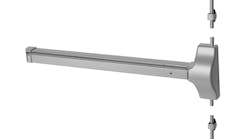The panic bar, crash bar, push bar, exit device or what my 5-year-old son calls a “pushy” (we still are working on his part number SKUs): Whatever you call this life-saving hardware, it’s essential to any facility and for good reason.
The exit device, as with many innovations in our industry, was born out of tragedy. On Dec. 30, 1903, 1,700 people were enjoying a matinee at the Iroquois Theatre in Chicago. Little did they know that 602 would perish that day.
When a fire broke out, people panicked and stampeded toward the exit, only to be trampled by others trying to shove their way out of an in-swing door. Most people would have made it out of the theatre safely if there had been outward-swinging doors that had panic hardware that opened easily when pushed. This event inspired changes to the hardware and codes that have kept us safe since.
Nowadays, most people use panic devices without thinking about it. People push, kick, bump or back up through these openings every day. If you’re a Door Dork like I am, you likely pay a bit more attention to what exit devices you service and supply. You also most likely have a fair understanding of the codes that regulate the use of exit devices. But are you aware of all of the security vulnerabilities that exist with exit devices? Perhaps not.
Let’s dive into the three main threats to exit devices and how you can mitigate them. Along the way, I’ll explain how I broke into a building using nothing but a wire hanger (with permission, of course).
Threat No. 1: Trim
I see it every day: a bashed-in knob, a broken-off lever and lever trim that you can spin like it was the Wheel of Fortune. Door hardware is an open invitation to vandalism, so it seems. The potential for malicious damage isn’t limited to big cities or specific types of buildings. We see it in schools, hospitals and colleges, in small towns and large cities alike. Practically anywhere there’s an exposed exterior door, you potentially could have this issue.
Breakaway lever trims might seem like a good option, because they keep out intruders, but after the encounter, the door has hardware that’s a pain to fix or replace.
So, what’s the solution? The doors that seem to receive the least amount of vandalism are high-quality steel doors that have little to no trim exposed. Removing or replacing levers with vandal-resistant equivalents wherever you can eliminates this potential liability. It’s quite simple, but effective: A door that doesn’t have anything to vandalize won’t be vandalized.
Beyond vandalism, unsecure trims, levers and pulls also can create dangerous situations for people in a facility. Double-door pulls, specifically, can be an easy target for someone who has a misguided agenda and uses something as simple as a bike lock, chain or even a broomstick. The industry learned that the hard way at the Virginia Tech shooting, when an undergraduate at the university chained three main exits shut, preventing students and teachers from escaping the building.
This threat can be avoided easily by replacing standard pulls with vandal-resistant pulls or by simply removing one of the two pulls.
Threat No. 2: Glass Doors
Many in the industry believe that glass doors and security are mutually exclusive: You can have glass doors, or you can have security but not both. Aesthetically, glass doors are appealing. They let in lots of natural light, which is proven to improve occupant well-being and productivity. This makes the doors popular among owners, developers and architects. Glass doors aren’t going anywhere.
So, how do you make sure your glass doors are as secure as possible? It all comes down to what type of exit device you have and, more important, how it latches.
When exit devices were designed for glass doors, they were made primarily with a roller latch. The vulnerability of this device is written into the name of the latch — roller. With enough force and the right timing, you can rock and “roll” open one of these doors.
Since then, manufacturers have developed the Pullman-style latch, which engages with the strike through a larger footprint, thus being more secure and preventing people from rocking open a door. The solution then is simple: Don’t use a roller-latch exit device on a glass door.
Threat No. 3: Intruder Tools
Six months ago, I stumbled across a video that showed some creative, yet illegal, ways of getting through doors. It was alarming. I had to know for myself whether these techniques really worked. Sometimes, to prevent intrusion, you have to think like an intruder.
I had known about a few of these techniques, such as the under-the-door lever tool and the smoke release of maglocks. What caught me by surprise was how easy it was for the intruders to use a J-Tool, also known as a double-door tool or a J-Hook, to defeat vertical-rod exit devices and break into a building.
The J-Tool was designed to be used by firefighters as way to get through double doors that have vertical rods while causing minimal to no damage to the door itself. This tool isn’t fancy, just some reinforced wire shaped like a “J.” In case of an emergency, firefighters would slip the J-Tool between the double doors, hook one of the push bars and pull open the door with a yank. Unfortunately, a good tool in the wrong hands can be dangerous.
The J-Tool technique seemed like the simplest one to try out, so I headed to my local school district to ask their staff locksmith whether I could test this method. The locksmith hadn’t heard of a J-Tool but agreed to have me demonstrate the potential security breach on one of his facility’s doors. After I had permission, I reached into the back of my closet and made my own J-Tool out of a wire hanger.
We met at the back entry of a large facility that had double doors that had vertical rods. The doors normally were locked. Although my wire hanger version wasn’t as sturdy as an actual J-Tool used by first responders, after a little finessing, we were in. The attack took less than two minutes.
My simple experiment was eye-opening. I was shocked knowing that several other institutional facilities in the area have the same types of openings throughout their buildings. Simple math highlighted that this simple tool potentially could defeat thousands of similar doors.
So how can you protect facilities from this attack? There are several ways, and all include restricting access to the space in between the doors.
One solution comes with a heavy lift: Adding a door mullion and changing the vertical rods to rim exit devices would prevent a wire hanger from slipping in between the doors. This solution can be quite expensive and might not be applicable because of the adjusted door widths to maintain Americans with Disabilities Act compliance. A well-installed security astragal that covers the full length of the doors would be the simplest and most cost-effective way to prevent this intrusion.
You might believe that a simple latch guard will do the trick, but seeing how there isn’t any latch to guard on vertical rods, it seems out of place, and there still could be vulnerabilities in reaching the bars from above or below the latch guard. As far as weather stripping preventing this from happening, it didn’t in my case. My J-Tool slipped right through the doors, weather stripping and all.
The three threats outlined here: trims, roller latches and use of a J-Tool, ought to be considerations for the next exit device you install. Regardless of the brand you use, being aware of fire and life-safety codes as well as the security threats that come with your device are important, so you can avoid any vulnerabilities. Remember: Think like an intruder.
Benji Bolick, The Door Dork, is a door security solutions end-user specialist for ASSA ABLOY Opening Solutions and is “obsessed” with doors and hardware. Check out more of his content and join the Door Dork community on LinkedIn: Benji Bolick the Door Dork #doordork






